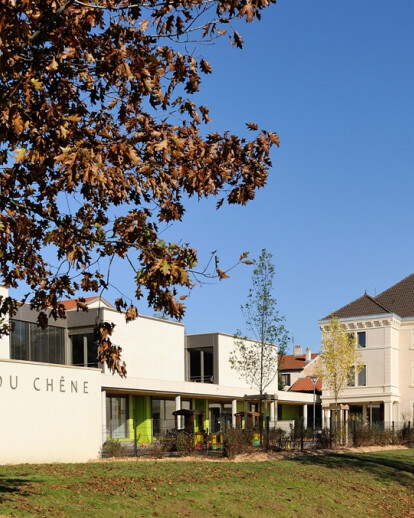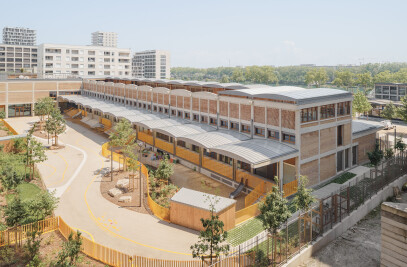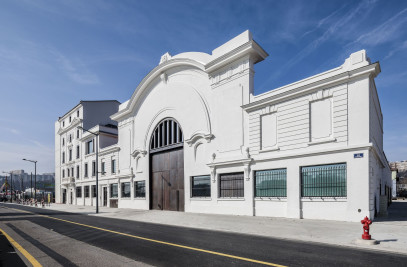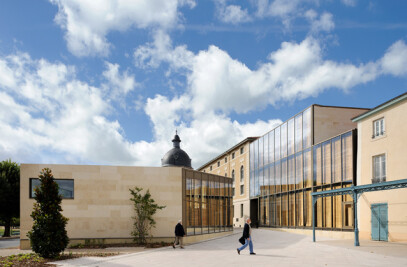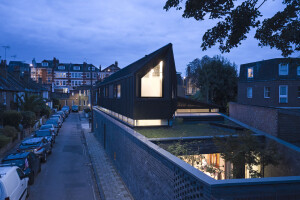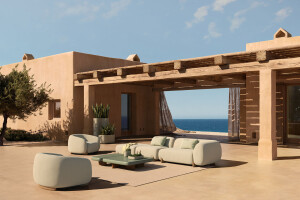Revealing
The project is situated in the town of Fleurieux sur l’Arbresle, in the Rhône region of France, on a former wine-producing estate: The Domaine du Chêne. The undulating terrain, with its swathes of majestic trees, overlooks the Monts du Lyonnais hills and offers breathtaking views as well as an advantageous southern aspect. The chateau, formerly a bourgeois residence, takes centre stage at the very heart of the grounds.
The local town council acquired the property in the 1950s and has since used the building as a school, using extensions and prefabricated classrooms as needed to meet the challenge of creating an appropriate space for the pupils. The limitations of this intuitive, piecemeal installation over time, along with increased demand for school places eventually forced the client to consider fully restructuring the school buildings.
The agency Pierre Vurpas et Associés Architectes, won the competitive bid for the project in 2010 with a simple, but by no means simplistic, proposal in which the new buildings were clearly distinct from the renovated chateau and the outbuildings, which in the past were used to store bottles of wine.
Each element has its role to play, striking just the right balance of elegance, sobriety and playfulness. The contemporary lines dramatically and harmoniously reveal the full splendour of this heritage of architecture and landscape.
Striking the right balance
The renovation The project is divided into two distinct yet complementary parts. The first is the renovated chateau and the outbuildings. The buildings located to the north of the plot were turned into housing and detached from the property along with the vineyard.
The painstaking and respectful renovation was intended to restore the chateau to its former glory, at the heart of its historic grounds. Its original architectural features were restored: the proportions of the facades with the reintroduction of wooden louvered shutters, the restoration of the canopy over the south-facing perron, the lime plaster coating on the facades, and the cleaning of the stone string course.
The extension The new building is a natural extension of the renovated outbuildings. It is set back from the chateau, alongside the main facade, as if keeping itself at a polite distance. The old and new buildings are connected by a glass-covered walkway, a rift of light, creating a point of harmony between the two buildings and their facades.
This sober, contemporary space stretches out horizontally over two floors. The horizontality is further emphasised by the string course on the upper floor and the walkway on the ground floor. As well as the covered walkway, the block form is hollowed out on the top floor to form two terraces which also provide shade.
The facade is coated with a lime and cement mortar which harmonises with the facade of the chateau and gives a velvety, luminous finish. The soft green chosen for the doors and metalwork on the ground floor provides a welcome contrast.
The topography The project is built on a steeply sloping terrain with a gradient equivalent to one floor. The ingenious use of the north-south slope means the ground floor is kept on the same level as the chateau and offer direct access to the upper walkway. The components of the programme which require less natural light are built into the slope (plant rooms, dormitories etc.).
Striking the right note
The overall organisation and distribution of the programmes is remarkably clear and simple. The six primary school classes are housed in the chateau, one in each wing over three floors. This arrangement is perfectly adapted to the morphology and symmetry of the existing building.
On the ground floor, the Head Teacher’s office is strategically situated between the nursery school and the primary school. It is in the middle of the administrative block which forms a junction between the chateau, the new extension and the renovated outbuildings.
The outbuildings provide a covered play area as an extension of the open air playground. The first floor is home to the IT and audiovisual rooms which are open for use at certain times of the year by local associations.
The four nursery school classes can be found in the southern part of the new building. The classrooms all have direct access to the playground, beautiful views across the surrounding countryside and, although they get plenty of direct sunlight, they are shaded by the external covered walkway. A dormitory for the nursery school pupils’ nap is laid out around the patio which provides an additional source of daylight. The nursery school is accessed through wide corridors fitted with wooden coat-pegs and cubby holes along the walls. The children’s toilets follow on from the classrooms and open directly onto the southern side of the project. They open out onto the nursery pupils’ playground providing a source of natural light and ventilation.
A large school hall, with a direct access from the main entrance, occupies a central position between the two schools. The acoustic is tempered by the slatted wooden wall panels. Three vertical window panels at irregular intervals in the hall walls filter the light and the view in and out of the hall. A large oval skylight lights up the soft flooring. The 130m² space is denoted with the use of the peacock blue colour which gives it its own special atmosphere and indicates its specific, separate role.
Communal activities take place on the first floor, accessed by the main, wide, open staircase. The facilities on this floor include the school canteen composed of a large kitchen and two dining rooms. The kitchen is fully equipped and the school meals are freshly prepared by an on-site chef using local produce. The back of the canteen area offers a level, direct access for staff and facilitates maintenance interventions in the kitchen and to the heating system. The main features of the dining rooms are the two large bay windows which frame the landscape beyond.
The first floor facilities are completed with a library and art room which are also available for use by local holiday and after-school playscheme.
Combining comfort and contemporary design
The resolutely contemporary architectural feel of the building remains gentle and respects the scale and features of a space used by and for children.
The key feature is the permanent interaction between the building and its majestic natural surroundings. The upper part of the terrain is protected woodland, and the grounds are an integral part of the project. The large bay windows are like landscape paintings, and on the first floor give the impression of living in the treetops.
A variety of intermediate areas, halfway between the outside and the inside, create spaces for play, passages and accesses. These include the nursery and primary school playgrounds, the pedestrian accesses, the perron, the esplanade, the staircases and the walkway...
Natural light, as well as vegetation, is omnipresent throughout the building, creating a sense of well-being, comfort and security. Inside, transom windows and glazed patios bring light right into the heart of the project. The large dimensions of the transit areas enhance this feeling of comfort.
The colours used are mainly light tones, contrasted with the soft green, like oak trees in the spring, which forms the project’s leitmotif. The acoustic ceiling made of wooden slats in the corridors and walkways marks the way to the main entrances and provides additional warmth and substance.
The furniture both meets the ergonomic requirements for school equipment, and strikes a playful, joyous note, just as the teachers combine education and play in the classroom. For example, the luminous globes suspended from the ceiling like balloons in the canteen, the wooden cubby holes along the corridors, the design details in the toilets for the nursery school pupils.
Respecting the environment
As for most contemporary architecture projects, the new school in Fleurieux is equipped with a number of features to reduce its impact on the environment, reduce its energy consumption and optimise its efficiency. A “clean worksite charter” for projects built on occupied sites was adhered to, with the aim of reducing disruption and potential risks to a minimum.
The decision to renovate the chateau is in itself an environmentally sound approach, both in economic and philosophical terms. As for the new building, it conforms to the principles of bioclimatic design and has been designed to make the most of its advantageous aspects. The classrooms are mainly south or south-east facing and open to the exterior. They benefit from maximum sunlight and solar gains, tempered by the covered walkway created by the first floor overhang. On the first floor, sunshades protect the windows from excessive heat. Taking advantage of the topography of the terrain by building certain parts of the structure into the slope also optimises the ground thermal inertia. This limits energy losses from north-facing structures and avoids overheating in the summer.
The project is compact and the structure, which is entirely made of concrete, has high thermal inertia as well as external insulation which ensures thermal comfort in the summer months. The nursery school is fitted with heated flooring, with additional heating from radiators.
The building has a wood-fueled heating system and the existing gas system has been conserved for use as a back-up system and/or for additional heating in periods of extreme cold.
Heat recovery ventilation is used to provide fresh air whilst the natural ventilation provides climate control within the building. Air tightness testing was successfully carried out during the construction process. The materials used were chosen to limit their impact on the environment and ensure that their composition would have no harmful effects in the short or long term.
The green roofs provide insulation on the terrace roofs, control stormwater runoff and infiltration and ensure the building blends into its natural surroundings. Planted with flowering meadow plants whose colours change with the seasons, it contributes to the vibrant, joyful feel of the school.
The retention basins, buried under the lawn areas of the playground, also serve to control stormwater flows.
Main materials used: - Lacquered metallic wall panel with external insulation (new extension, ground floor) - Hydraulic lime plaster with external insulation (new extension, first floor) - Lacquered metallic louvered screens with external insulation (new extension, first floor) - Repointed limestone string course and crown (new extension, first floor) - Lacquered venetian blinds (new extension, first floor) - Lacquered aluminium work (new extension) - Green roof (new extension) - Wooden shutters (chateau renovation) - Woodwork (chateau renovation) - Tiled roof (renovation + new extension - detached farm) - Lime plastering and paintwork (renovation)
